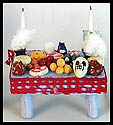


Celebrating the Mexican Holiday
Los Dias de los Muertos
(The Days of the Dead)

Every autumn Monarch Butterflies, which have summered up north in the United States and Canada, return to Mexico for the winter protection of the oyamel fir trees. The locale inhabitants welcome back the returning butterflies, which they believe bear the spirits of their departed. The spirits to be honored during Los Dias de los Muertos
Los Dias de los Muertos, the Days of the Dead, is a traditional Mexico holiday honoring the dead. It is celebrated every year at the same time as Halloween and the Christian holy days of All Saints Day and All Souls Day (November 1st and 2nd). Los Dias de los Muertos is not a sad time, but instead a time of remembering and rejoicing.
The townspeople dress up as ghouls, ghosts, mummies and skeletons and parade through the town carrying an open coffin.
The "corpse" within smiles as it is carried through the narrow streets of town. The local vendors toss oranges inside as the procession makes its way past their markets.
Lucky "corpses" can also catch flowers, fruits, and candies.

In the homes families arrange ofrenda's or "altars" with flowers, bread, fruit and candy. Pictures of the deceased family members are added. In the late afternoon special all night burning candles are lit - it is time to remember the departed - the old ones, their parents and grandparents.
The next day the families travel to the cemetery. They arrive with hoes, picks and shovels. They also carry flowers, candles, blankets, and picnic baskets. They have come to clean the graves of their loved ones. The grave sites are weeded and the dirt raked smooth. The Crypts are scrubbed and swept. Colorful flowers, bread, fruit and candles are placed on the graves. Some bring guitars and radios to listen to. The families will spend the entire night in the cemeteries.
Skeletons and skulls are found everywhere. Chocolate skulls, marzipan coffins, and white chocolate skeletons. Special loaves of bread are baked, called pan de muertos, and decorated with "bones.



Handmade skeleton figurines, called calacas, are especially popular. Calacas usually show an active and joyful afterlife. Figures of musicians, generals on horseback, even skeletal brides, in their white bridal gowns marching down the aisles with their boney grooms.
The celebration of Los Dias de los Muertos, like the customs of Halloween, evolved with the influences of the Celtics, the Romans, and the Christian holy days of All Saints Day and All Souls Day. But with added influences from the Aztec people of Mexico.
The Aztecs believed in an afterlife where the spirits of their dead would return as hummingbirds and butterflies. Even images carved in the ancient Aztec monuments show this belief - the linking the spirits of the dead and the Monarch butterfly.
Dia de Los Muertos Parade - Oaxaca, Mexico
setTemplate('halloween'); print $articles; ?>

